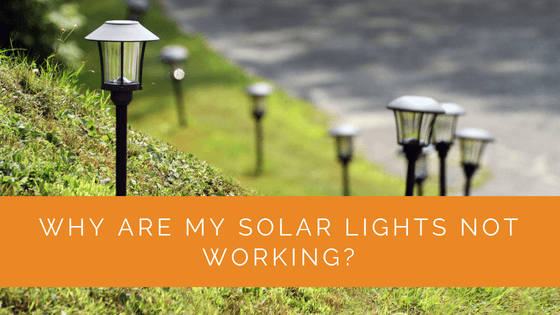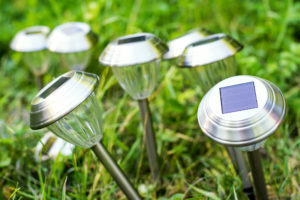Solar lights are a fantastic choice for outdoor lighting, especially for those who want to save money and reduce their carbon footprint. They are easy to install and can be moved around whenever you need to rearrange your garden or patio. Plus, they don't rely on electricity, making them a more sustainable option compared to traditional lights. However, like any other technology, solar lights can encounter issues that prevent them from functioning properly. If your solar lights suddenly stop working, don't panic! There are several common reasons why this might happen, and in this guide, I’ll walk you through how to troubleshoot and fix them. Let’s dive into the details. Contents First things first, let's explore some of the most common reasons why your solar lights might not be working as they should: One of the most overlooked issues is that solar lights often come with batteries that are not activated. New batteries usually have a protective tab that prevents them from discharging during transportation. To get your solar lights working, simply remove this tab and allow the batteries to charge fully under sunlight. Solar lights require a significant amount of sunlight to charge effectively. If your lights are placed in a shady area or under a tree, they won't receive enough light to power the battery. Try relocating your lights to a spot where they can catch the sun for at least six hours a day. Most solar lights have sensors that detect darkness and activate the lights at night. If these sensors are faulty, your lights may not turn on even when it's dark. To check if your sensor is working, cover it with your hand or a piece of paper during the night. If the light turns on, your sensor is likely fine. If not, you may need to replace it. Dirt and debris can accumulate on the solar panels, blocking sunlight and preventing the lights from charging. Similarly, water can seep into the panels and damage the internal components. Regularly clean the panels with a soft cloth and soapy water to keep them in top condition. Also, inspect the panels for any signs of water damage. Solar lights can be sensitive to other light sources, such as streetlights or nearby house lights. If these lights are too close to your solar lights, they might confuse the sensor and prevent the lights from turning on at night. Relocate your solar lights away from these sources to avoid interference. Batteries have a limited lifespan and eventually wear out. If your lights have been working fine for several years, it’s likely time to replace the batteries. Look for high-quality rechargeable batteries like NiMH or lithium-ion, which last longer and perform better than standard alkaline batteries. Even if your solar panels and batteries are functioning correctly, a faulty LED bulb can prevent your lights from working. Check the bulbs regularly and replace them if they appear dim or burnt out. LED bulbs are relatively inexpensive and easy to swap out. Solar lights rely on internal cables to connect the solar panel to the battery and the light itself. If these cables are damaged, the entire system can fail. Inspect the cables for any visible damage, such as fraying or breaks. If you notice any issues, it’s best to consult a professional electrician to repair or replace them. Now that you know some of the common reasons why solar lights stop working, here’s a step-by-step guide to help you fix them: Relocate your solar lights to a spot where they can receive direct sunlight for at least six hours a day. Avoid placing them under trees or near tall buildings that block sunlight. Remove the batteries and check if they have a protective tab. If so, remove the tab and allow the batteries to charge under sunlight for a day or two. Test the lights afterward to see if they work. Cover the sensor with your hand or a piece of paper during the night. If the light turns on, the sensor is working fine. If not, consider replacing the sensor. Use a soft cloth and mild soap to clean the solar panels. Make sure to remove any dirt, leaves, or debris that may be obstructing sunlight. Rinse thoroughly with water and dry the panels completely before reinstalling. Check the cables connecting the solar panel, battery, and light for any visible damage. If you notice any issues, replace the cables or consult a professional for assistance. If your LED bulbs are dim or burnt out, replace them with new ones. Make sure to use high-quality bulbs that match the specifications of your solar lights. By following these steps, you should be able to identify and fix the issues preventing your solar lights from working. Remember, regular maintenance is key to keeping your solar lights in good condition and ensuring they last for years to come. Happy lighting! I’m Alex, a passionate advocate for sustainable living and renewable energy. Over the years, I’ve helped countless individuals and families transition to solar-powered solutions. My goal is to empower people with knowledge and practical tips to make informed decisions about their energy usage. Feel free to reach out if you have any questions or need advice on solar lighting or other eco-friendly initiatives. Designed to perform the shearing and removal of the excess of metal accumulated during the welding, leveling in a homogeneous way the portion of the welded rail. It consists of a powerful hand pump which moves two hydraulic cylinders with the mobile shearing blade applied on, that, during the removing of the material, leans against the fixed cutting blades. The cutting blades are easily replaceable so as to adapt the tool to the rail profile to be processed. Two handles are placed in a well-balanced point, allowing an easy movement of the machine. Weld Trimmer,Hydraulic Weld Trimmer,Rail Weld Trimmer,Thermit Weld Trimmer Shenyang Lubang Railway Maintenance Machinery Co.,Ltd. , https://www.srmfrailwayequip.com
Key Takeaways
Common Reasons Why Solar Lights Stop Working

Batteries Need Activation
Insufficient Sunlight
Malfunctioning Sensors
Accumulated Dirt or Water
Interference from Nearby Light Sources
Dead or Worn-Out Batteries
Faulty LED Bulbs
Damaged Cables
Step-by-Step Guide to Fixing Solar Lights
Ensure Sufficient Sunlight
Check and Activate Batteries
Test the Sensors
Clean the Panels
Inspect Cables
Replace Bulbs
About the Author